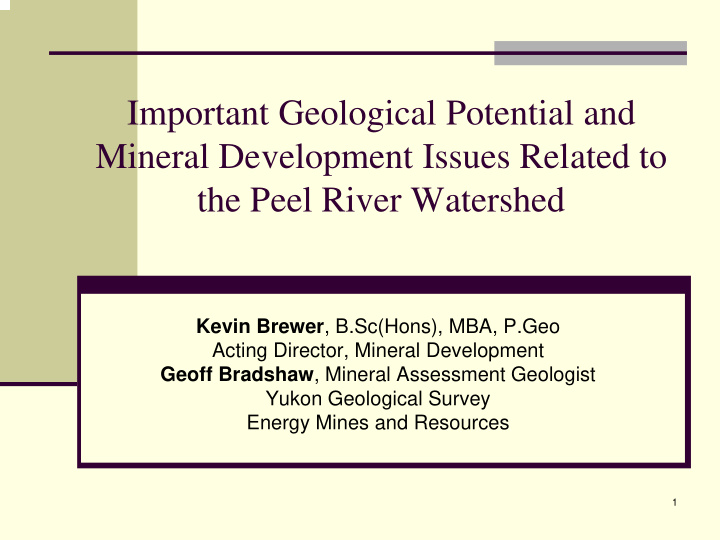



Important Geological Potential and Mineral Development Issues Related to the Peel River Watershed Kevin Brewer , B.Sc(Hons), MBA, P.Geo Acting Director, Mineral Development Geoff Bradshaw , Mineral Assessment Geologist Yukon Geological Survey Energy Mines and Resources 1
Overview � Goals and Objectives – Our Interest � Geological Potential and Known Mineral Deposits � Importance of Access Corridors and Critical Perspectives 2
Goal Sharing � To maximize the land base available to mineral exploration � To ensure the sustainable development of mineral resources while recognizing society’s environment and conservation objectives 3
Typical Objectives from the Mineral Sector in the Development of Land Use Strategies provide an holistic and forward looking approach to � land use successfully integrate land use, conservation and � protection objectives to address short-term and long-term needs and � realities Work cooperatively with a broad range of � stakeholders 4
Bedrock Geology in the Planning Region • The Bedrock geology mainly consists of rocks of the ancient margin of the North American craton • Stratigraphy is dominated by old carbonate and clastic sedimentary rocks • The geology of the Peel plateau is different, and consists of younger sedimentary rocks • Proterozoic (very old) inliers are important 5
Mineral Claims in the Planning Region • 2277 quartz claims in good standing covering approx. 633 km 2 • 6 Coal licenses • 525 Iron and Mica leases 6
Mineral Deposits in the Planning Region • 11 known mineral deposits • Coal: 7 deposits - Bonnet Plume basin • Iron Ore: Crest deposit • Other deposits include: • Goz zinc deposit • Pagisteel iron deposit • Hart River copper deposit 7
Mineral Occurrences in the Planning Region • 222 mineral occurrences • Represent approximately 16 different mineral deposit types 8
Mineral Potential in Planning Region • Relative to southern Yukon, the region has seen little mineral exploration • Regions with potential for the discovery of future resources are equally important to consider in land use planning • A regional mineral assessment completed in 1999 covers most of the planning region • An updated assessment is in progress 9
Mineral Potential of the Peel Watershed � Compared to other regions of the Yukon there is a high degree of uncertainty with regards to the overall mineral potential of the Peel Region due to: � The area is under-explored but yet appears to have vast potential (this is mainly due to lack of existing access and infrastructure into the region and the subsequent high cost of exploring) � Some key data (e.g. regional geophysics is missing) � Gaps also exist in current geological mapping 10
Known Major Mineral Resources in Peel River Watershed � Crest Iron Ore Deposit � Value: $59 billion � 32% of Yukon total reserves in overall gross value � Bonnet Plume Coal Deposits � Value: $7 billion � 4% of Yukon total reserves in overall gross value 11
Gross Mineral Resource Value Yukon Mineral Resource Value May 2005 60,000,000,000 50,000,000,000 40,000,000,000 30,000,000,000 20,000,000,000 10,000,000,000 - Tungsten Iron Molybdenum Gold Silver Nickel Platinum Palladium Coal Zinc Copper Lead Barite Cobalt 12
Overview � Goals and Objectives – Our Interest � Geological Potential and Known Mineral Deposits � Importance of Access Corridors and Critical Perspectives 13
Access Corridors � Any land use strategy in the Peel Watershed area must consider maintaining resource access to the major Iron ore and Coal reserves in the area � Access to highways, roads, winter roads and airstrips is critical for mineral exploration and development � Future exploration and extraction of unknown mineral resources must be maintained 14
Other Critical Perspectives � Specific strategies are needed to address operations in sensitive areas. However the key challenge is that the locations of specific habitat or high sensitivity areas are not well known � Good Legislation and Industry management Practices: � Yukon Quartz Mining Land Use Regulations (MLUR) under the Yukon Quartz Act � MLUR will also ensure that proponents comply with the requirements of YESAA � Improved industry best management practices and awareness of environmental concerns 15
Summary •Specific strategies are needed to address operations in sensitive areas that will provide certainty to industry and ensure work can and will proceed appropriately in these areas •Continued access to the region is critical to future mineral exploration and development •The Bonnet Plume coal deposits and the Crest iron deposit are best known and have the highest economic potential and represent approximately one-third of the gross value of known mineral deposits in the Yukon today •Regions with potential for the discovery of future mineral resources are equally important to those areas with known potential 16
Summary •A regional scale mineral resource assessment was completed in 1999 that included this region and outlined regions of higher mineral potential but more work is necessary to fully determine the potential of the region and improve our geological and geophysical databases. An updated mineral resource assessment is currently in progress. •The Planning Commission should assume there is a strong probability for the discovery of additional significant mineral deposits in the Peel Watershed as well as the critical importance of the existing known mineral deposits 17
18 Thank You
Recommend
More recommend